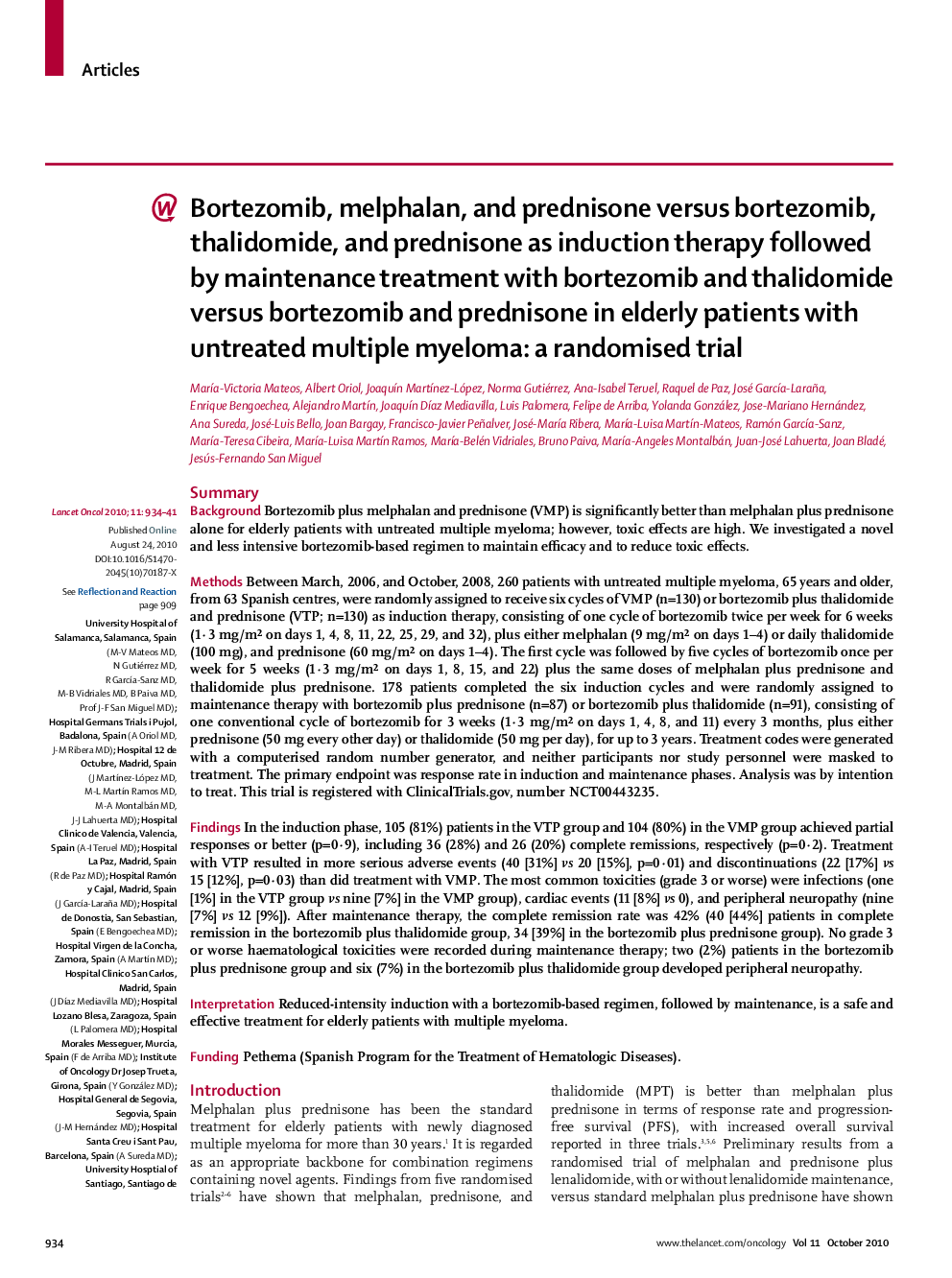| کد مقاله | کد نشریه | سال انتشار | مقاله انگلیسی | نسخه تمام متن |
|---|---|---|---|---|
| 3994979 | 1258924 | 2010 | 8 صفحه PDF | دانلود رایگان |

SummaryBackgroundBortezomib plus melphalan and prednisone (VMP) is significantly better than melphalan plus prednisone alone for elderly patients with untreated multiple myeloma; however, toxic effects are high. We investigated a novel and less intensive bortezomib-based regimen to maintain efficacy and to reduce toxic effects.MethodsBetween March, 2006, and October, 2008, 260 patients with untreated multiple myeloma, 65 years and older, from 63 Spanish centres, were randomly assigned to receive six cycles of VMP (n=130) or bortezomib plus thalidomide and prednisone (VTP; n=130) as induction therapy, consisting of one cycle of bortezomib twice per week for 6 weeks (1·3 mg/m2 on days 1, 4, 8, 11, 22, 25, 29, and 32), plus either melphalan (9 mg/m2 on days 1–4) or daily thalidomide (100 mg), and prednisone (60 mg/m2 on days 1–4). The first cycle was followed by five cycles of bortezomib once per week for 5 weeks (1·3 mg/m2 on days 1, 8, 15, and 22) plus the same doses of melphalan plus prednisone and thalidomide plus prednisone. 178 patients completed the six induction cycles and were randomly assigned to maintenance therapy with bortezomib plus prednisone (n=87) or bortezomib plus thalidomide (n=91), consisting of one conventional cycle of bortezomib for 3 weeks (1·3 mg/m2 on days 1, 4, 8, and 11) every 3 months, plus either prednisone (50 mg every other day) or thalidomide (50 mg per day), for up to 3 years. Treatment codes were generated with a computerised random number generator, and neither participants nor study personnel were masked to treatment. The primary endpoint was response rate in induction and maintenance phases. Analysis was by intention to treat. This trial is registered with ClinicalTrials.gov, number NCT00443235.FindingsIn the induction phase, 105 (81%) patients in the VTP group and 104 (80%) in the VMP group achieved partial responses or better (p=0·9), including 36 (28%) and 26 (20%) complete remissions, respectively (p=0·2). Treatment with VTP resulted in more serious adverse events (40 [31%] vs 20 [15%], p=0·01) and discontinuations (22 [17%] vs 15 [12%], p=0·03) than did treatment with VMP. The most common toxicities (grade 3 or worse) were infections (one [1%] in the VTP group vs nine [7%] in the VMP group), cardiac events (11 [8%] vs 0), and peripheral neuropathy (nine [7%] vs 12 [9%]). After maintenance therapy, the complete remission rate was 42% (40 [44%] patients in complete remission in the bortezomib plus thalidomide group, 34 [39%] in the bortezomib plus prednisone group). No grade 3 or worse haematological toxicities were recorded during maintenance therapy; two (2%) patients in the bortezomib plus prednisone group and six (7%) in the bortezomib plus thalidomide group developed peripheral neuropathy.InterpretationReduced-intensity induction with a bortezomib-based regimen, followed by maintenance, is a safe and effective treatment for elderly patients with multiple myeloma.FundingPethema (Spanish Program for the Treatment of Hematologic Diseases).
Journal: - Volume 11, Issue 10, October 2010, Pages 934–941